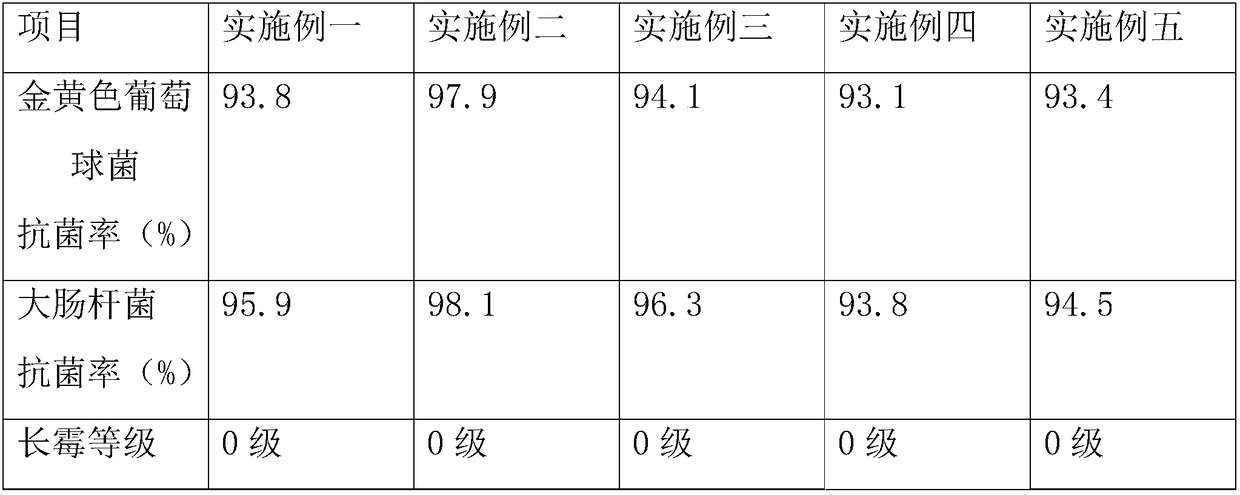Novel environmental-friendly wood-plastic composite board and preparation method thereof
A composite board and wood-plastic technology, applied in the field of composite materials, can solve problems such as inability to meet people's requirements, material structural damage, and large differences in surface polarity, and achieve the effect of eliminating bad odor, strong adsorption capacity, and improving adsorption capacity.
- Summary
- Abstract
- Description
- Claims
- Application Information
AI Technical Summary
Problems solved by technology
Method used
Image
Examples
Embodiment 1
[0036] This embodiment provides a new type of environmentally friendly wood-plastic composite board, in parts by weight, including the following raw material components: 55 parts of polyethylene, 12 parts of polypropylene, 15 parts of ABS plastic, 55 parts of wood flour, 15 parts of ramie fiber, and calcite 10 parts of powder, 7 parts of talc powder, 8 parts of shell powder, 10 parts of diatomaceous earth, 5 parts of sepiolite powder, 4 parts of zeolite powder, 2 parts of Beitou powder, 0.1 part of titanium dioxide, 3 parts of pine needle powder, Naringenin 1.5 parts, 2 parts of thyme, 1 part of tamarind shells, 3 parts of naked purple beads, 1.5 parts of holly leaves, 1.5 parts of Nepeta, 0.3 parts of coupling agent, 6 parts of stabilizer, 2.5 parts of compatibilizer.
[0037] In this embodiment, the stabilizer is made by mixing zinc stearate and calcium stearate at a mass ratio of 1:3; the compatibilizer is made of maleic anhydride grafted polyethylene and maleic anhydride graft...
Embodiment 2
[0045] This embodiment provides a new type of environmentally friendly wood-plastic composite board, which, in parts by weight, includes the following raw material components: 55 parts of polyethylene, 15 parts of polypropylene, 15 parts of ABS plastic, 60 parts of wood flour, 15 parts of ramie fiber, and calcite 12 parts of powder, 7 parts of talc powder, 10 parts of shell powder, 10 parts of diatomaceous earth, 8 parts of sepiolite powder, 4 parts of zeolite powder, 2 parts of Beitou powder, 0.5 part of titanium dioxide, 3 parts of pine needle powder, Naringenin 2 parts, 2 parts of thyme, 1.5 parts of tamarind shells, 3 parts of nude flower purple beads, 2 parts of holly leaves, 1.5 parts of Nepeta, 0.5 parts of coupling agent, 6 parts of stabilizer, 4 parts of compatibilizer.
[0046] In this embodiment, the stabilizer is made by mixing zinc stearate and calcium stearate at a mass ratio of 1:3; the compatibilizer is made of maleic anhydride grafted polyethylene and maleic anhyd...
Embodiment 3
[0054] This embodiment provides a new type of environmentally friendly wood-plastic composite board, which, in parts by weight, includes the following raw material components: 52 parts of polyethylene, 13 parts of polypropylene, 14 parts of ABS plastic, 58 parts of wood flour, 13 parts of ramie fiber, and calcite 11 parts of powder, 6 parts of talcum powder, 9 parts of shell powder, 9 parts of diatomaceous earth, 7 parts of sepiolite powder, 3.5 parts of zeolite powder, 1.5 parts of Beitou powder, 0.3 parts of titanium dioxide, 2.5 parts of pine needle powder, Naringenin 1.7 parts, thyme 1.8 parts, tamarind shell 1.2 parts, naked flower purple beads 2.5 parts, holly leaf 1.8 parts, nepeta 1.3 parts, coupling agent 0.4 parts, stabilizer 5 parts, compatibilizer 3.5 parts.
[0055] In this embodiment, the stabilizer is made by mixing zinc stearate and calcium stearate at a mass ratio of 1:3; the compatibilizer is made of maleic anhydride grafted polyethylene and maleic anhydride graf...
PUM
| Property | Measurement | Unit |
|---|---|---|
| particle size | aaaaa | aaaaa |
| particle size | aaaaa | aaaaa |
| thickness | aaaaa | aaaaa |
Abstract
Description
Claims
Application Information
 Login to View More
Login to View More - R&D
- Intellectual Property
- Life Sciences
- Materials
- Tech Scout
- Unparalleled Data Quality
- Higher Quality Content
- 60% Fewer Hallucinations
Browse by: Latest US Patents, China's latest patents, Technical Efficacy Thesaurus, Application Domain, Technology Topic, Popular Technical Reports.
© 2025 PatSnap. All rights reserved.Legal|Privacy policy|Modern Slavery Act Transparency Statement|Sitemap|About US| Contact US: help@patsnap.com

